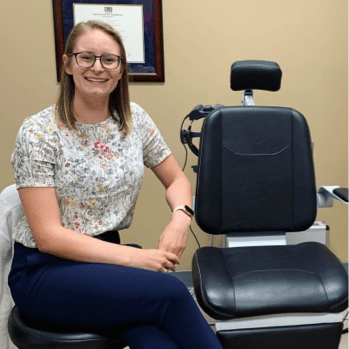Does your child avoid reading or complain of headaches after school? Do they find their eyes feel tired and strained after looking at a screen? These experiences can be linked to how our eyes focus, and sometimes, that system needs a little support.
Think of the eye’s lens like the lens of a camera: it needs to adjust to keep objects clear at different distances. When this focusing system doesn’t work as efficiently as it should, your child might experience a range of visual challenges that can affect daily life. This condition is known as accommodative dysfunction.
The Different Types of Accommodative Dysfunction
This focusing issue can show up in a few different ways, each with its own unique challenges. During a comprehensive eye exam, we can determine which type may be affecting your child. The 3 main types are described below.
Accommodative Insufficiency
This is the most common type of focusing problem. It means having difficulty sustaining focus on near objects, like a book, tablet, or craft project. Reading for more than a few minutes might feel like a chore.
Accommodative Infacility
This type makes it hard to switch focus between objects at different distances. An example is looking from notes on a desk up to a presenter at the front of the room. This can be particularly frustrating in a classroom setting.
Accommodative Spasm
This happens when the eye’s focusing muscle has a cramp and has trouble relaxing. It’s like the focusing system gets “stuck” in near gear. This often causes distance vision to become blurry after doing near work.
What Does Accommodative Dysfunction Look Like?
The signs of a focusing problem can impact comfort, attention, and performance during everyday activities. Because our focusing system is so active, the symptoms can appear in many different ways. Your child might experience:
- Blurred vision that comes and goes, especially with near tasks
- Headaches located over the brow or on the temples
- Eye strain, burning, or general fatigue after short periods of reading
- Avoidance of homework, reading, or other detailed near work
- Needing to take frequent breaks from visually demanding tasks
These symptoms are a sign that it’s time to seek professional eye care. Getting a clear picture of your child’s visual skills is the first step toward finding relief.
Common Causes and Risk Factors
Accommodative dysfunction is not an eye disease. It’s a functional problem with your child’s visual skills. Certain factors can contribute to its development by placing extra stress on the focusing system. Some common factors include:
- An inability of the eyes to work together properly due to a condition known as binocular vision dysfunction. When the eyes struggle to align, it puts extra stress on focusing.
- Increased visual demand from spending many hours on digital screens. Our modern lives demand a lot from our eyes, and this constant near work can challenge our focusing stamina.
- Long periods of visually demanding near work without sufficient breaks. Adopting simple habits, like the 20-20-20 rule, can make a difference.
- Poor ergonomics, such as improper lighting or posture when working or reading.

How We Diagnose Accommodative Dysfunction
A standard vision screening that only checks your distance clarity can miss a focusing problem. That’s why we take a comprehensive approach to eye care at Beyond 20/20 Optometry. To find the source of the problem, we perform a few key steps during an exam:
- We talk with you about symptoms, daily activities, and visual demands.
- We perform a thorough eye health and vision exam to assess overall ocular wellness.
- We use specific tests to evaluate focusing abilities and how well the eyes work together as a team.
How Do You Fix Accommodative Dysfunction?
After a comprehensive assessment, your eye doctor can recommend a personalized treatment plan. The goal is always to help your child see more clearly and comfortably, so they can succeed at school and in life. Your child’s plan may include one or both of the following.
Prescription Lenses
Specialized glasses or contact lenses can help relieve the strain on your focusing system. These are not just standard reading glasses; they are designed to support your unique visual needs. This may include lenses just for near work or multifocal lenses that help with focus at various distances.
Optometric Vision Therapy
Vision therapy is a personalized program of activities designed to help improve the connection between the brain and the eyes. It can be an effective treatment for a variety of conditions, including amblyopia (lazy eye) and strabismus (crossed eyes).
This therapy helps your child develop the visual skills needed for quick, accurate, and comfortable focusing. Unlike glasses that passively support vision, vision therapy is an active process that helps retrain the visual system, making focusing feel more automatic.
Support Your Child’s Vision Today
With a proper diagnosis and management plan, many people find significant relief from the symptoms of accommodative dysfunction. The first step is to schedule a comprehensive vision and eye health exam for your child to address the root of your concerns. If you are searching for dedicated eye care in Moncton, our team at Beyond 20/20 Optometry can help. A full evaluation of your child’s visual skills can provide the answers you and your family need. Book an appointment with us today to take the next step toward clearer, more comfortable vision.




